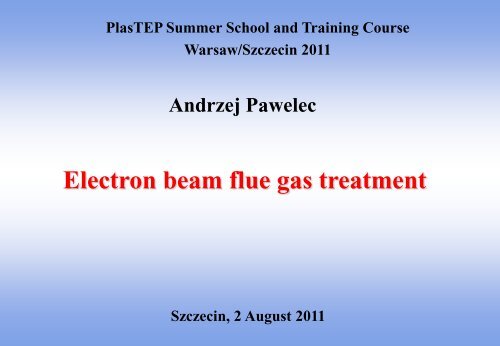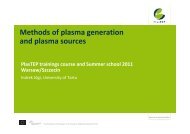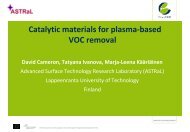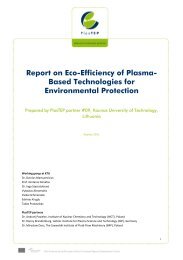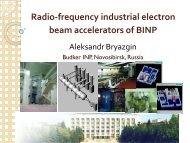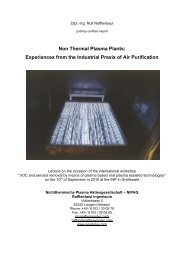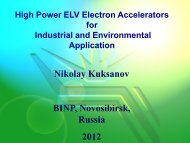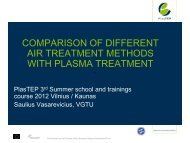Electron Beam Flue Gas Treatment - PlasTEP
Electron Beam Flue Gas Treatment - PlasTEP
Electron Beam Flue Gas Treatment - PlasTEP
- No tags were found...
You also want an ePaper? Increase the reach of your titles
YUMPU automatically turns print PDFs into web optimized ePapers that Google loves.
<strong>PlasTEP</strong> Summer School and Training Course<br />
Warsaw/Szczecin 2011<br />
Andrzej Pawelec<br />
<strong>Electron</strong> beam flue gas treatment<br />
Szczecin, 2 August 2011
Some history<br />
• Early phase (Japan, 1970s)<br />
• Pilot plants phase (Japan, USA, Germany, Poland 1980s,<br />
1990s)<br />
• Industrial plants phase (China, Poland, late 90s)<br />
• Recent attempts (China, Bulgaria, Middle East)<br />
Present operating plant:<br />
• EBFGT at Pomorzany Power Station, Poland<br />
• New facilities under construction
Technology basis
The idea of EBFGT<br />
Conventional process<br />
(wet-FGD + SCR)<br />
EBFGT
Pollutants removed by EB method<br />
The method has been designed for simultaneous removal of:<br />
• SO 2<br />
• NO x<br />
Also there proceeds removal of other pollutants as:<br />
• HCl, HF etc.<br />
• Volatile Organic Hydrocarbons (VOC)<br />
• Dioxins<br />
• Mercury<br />
• Others…
<strong>Electron</strong> beam effect on gas<br />
Primary radiolysis products<br />
4.43N eV 2<br />
0.29N 2*<br />
+ 0.885N( 2 D) + 0.295N( 2 P) + 1.87N( 4 S) + 2.27N 2+<br />
+ 0.69N + +<br />
2.96e -<br />
100<br />
<br />
5.377O eV 2<br />
0.077O 2*<br />
+ 2.25O( 1 D) + 2.8O( 3 P) + 0.18O * + 2.07O 2+<br />
+ 1.23O + + 3.3e -<br />
7.33H 2<br />
O 0.51H 2<br />
+ 0.46O( 3 P) + 4.25OH + 4.15H + 1.99 H 2<br />
O + + 0.01H 2+<br />
+<br />
0.57OH 100 eV + + 0.67H + + 0.06O + + 3.3 e -<br />
7.54CO 2<br />
4.72CO + 5.16O( 3 P) + 2.24CO 2+<br />
+ 0.51CO + + 0.07C + + 0.21O + + 3.03 e -<br />
100<br />
100 <br />
eV<br />
<br />
1. J.C. Person, D.O. Ham: Radiat. Phys. Chem. 31 (1988) 1<br />
2. H. Matzing: Model studies of flue gas treatment by electron beams, in: Application of isotopes and radiation in<br />
conservation of the environment, IAEA-SM-325/186, International Atomic Energy Agency, Vienna 1995, pp.<br />
115-124
<strong>Electron</strong> beam effect on gas<br />
Secondary reactions<br />
O( 1 D) + H2O 2OH *<br />
N 2<br />
+<br />
+ 2H 2 O<br />
*<br />
H 3 O + + OH + N 2<br />
O( 3 P) + O 2 + M O 3 + M<br />
e - + O 2 + M<br />
H 3 O + -<br />
+ O 2<br />
O - 2 * + M<br />
HO 2 + H2 O<br />
As a result of these primary and secondary reactions OH * ,<br />
HO 2<br />
*<br />
, O * radicals,O 3 and other oxidizing species are formed,<br />
that can oxidize NO, SO 2 and Hg
SO x / NO x removal
SO 2 removal pathways<br />
radiothermal<br />
SO 2<br />
+ OH* + M HSO 3<br />
+ M<br />
HSO 3<br />
+ O 2<br />
SO 3<br />
+ HO 2<br />
*<br />
SO 3<br />
+ H 2<br />
O H 2<br />
SO 4<br />
thermal<br />
H 2<br />
SO 4<br />
+ 2NH 3<br />
(NH 4<br />
) 2<br />
SO 4<br />
SO 2<br />
+ 2NH 3<br />
(NH 3<br />
) 2<br />
SO 2<br />
<br />
(NH 3<br />
) 2<br />
SO O 2 , H 2<br />
<br />
O <br />
2<br />
(NH 4<br />
) 2<br />
SO 4<br />
1. H. Namba: Materials of UNDP(IAEA)RCA Regional Training Course on Radiation Technology for<br />
Environmental Conservation TRCE-JAERI, Takasaki, September/October 1993, 99-104<br />
2. A.G. Chmielewski: Nukleonika 45(1) (2000) 31
NO x removal pathways<br />
NO oxidation<br />
NO 2 removal<br />
NO + O( 3 P) + M NO 2<br />
+ M<br />
O( 3 P) + O 2<br />
+ M O 3<br />
+ M<br />
NO + O 3<br />
+ M NO 2<br />
+ O 2<br />
+ M<br />
NO + HO 2<br />
* + M NO 2<br />
+ OH* +M<br />
NO + OH* + M HNO 2<br />
+M<br />
HNO 2 + OH* NO 2<br />
+ H 2 O<br />
NO 2<br />
+ OH* + M HNO 3<br />
+ M<br />
HNO 3<br />
+ NH 3<br />
NH 4<br />
NO 3<br />
H. Namba: Materials of UNDP(IAEA)RCA Regional Training Course on Radiation Technology for Environmental<br />
Conservation TRCE-JAERI, Takasaki, September/October 1993, 99-104
NO x reduction in the presence of<br />
ammonia<br />
NO + N( 4 S) N 2<br />
+ O<br />
NO 2<br />
+ N( 4 S) N 2<br />
O + O<br />
N( 2 D) + NH 3 NH* + NH 2 *<br />
NO + NH 2<br />
* N 2<br />
+ H 2<br />
O<br />
NO 2<br />
+ NH 2<br />
* N 2<br />
O + H 2<br />
O<br />
NO + NH* N 2<br />
+ OH*<br />
NO 2<br />
+ NH* N 2<br />
O + OH*<br />
H. Namba: Materials of UNDP(IAEA)RCA Regional Training Course on Radiation Technology for Environmental<br />
Conservation TRCE-JAERI, Takasaki, September/October 1993, 99-104
Simplified reaction mechanism<br />
HNO 3 NH 4 NO 3<br />
OH<br />
OH<br />
NO<br />
O, OH OH<br />
NO 2<br />
NH 3<br />
HNO 2<br />
OH O 2 , OH H 2 O<br />
SO 2 HSO 3 SO 3 H 2 SO 4<br />
NH 3<br />
NH 3<br />
(NH 3 ) 2 SO 2<br />
O 2 , H 2 O<br />
(NH 4 ) 2 SO 4
Reaction mechanisms and sequence<br />
of E-beam process
NO X removal factors<br />
NO x removal depends on such parameters as:<br />
• Dose (1 kGy = 1kJ/kg)<br />
• NO x inlet concentration<br />
• Ammonia concentration (stoichiometry)
SO 2 removal factors<br />
Main process parameters influencing SO2 removal efficiency :<br />
• Temperature<br />
• Humidity<br />
• Ammonia stoichiometry<br />
• Dose<br />
• Other parameters
Dependence of NO x and SO 2 removal<br />
efficiencies on dose
VOC/mercury removal
The structures of PAHs emitted from coal<br />
combustion<br />
naphtalene acenaphtene anthracene fluoranthene<br />
pyrene<br />
benzo(a)pyrene<br />
dibenzo(a,h) anthracene
PAHs’ emission at EB pilot plant<br />
at EPS Kawęczyn [μg/Nm 3 ]<br />
PAH name 2001 2000<br />
naphtalene n.m. 0.001 - 0.009<br />
acenaphtene C 12<br />
H 10<br />
0.005 – 0.006 0.354 – 1.027<br />
fluorene n.m – 0.022 0.119 – 0.592<br />
phenentrene 0.217 – 0.585 0.554 – 1.369<br />
anthracene C 14<br />
H 10<br />
0.128 – 0.487 0.324 – 0.367<br />
fluoranthene C 16<br />
H 10<br />
0.041 – 1.122 0.817 – 1.124<br />
pyrene C 16<br />
H 10<br />
0.105 – 0.244 0.093 – 0.607<br />
benzo(a)anthracene 0.153 – 5.750 2.804 – 4.680<br />
chrysene 0.537 – 2.305 0.555 – 1.604<br />
benzo(e)pyrene C 20<br />
H 12<br />
0.195 – 0.407 0.084 – 0.291<br />
benzo(a)pyrene 0.254 – 0.661 0.804 – 2.467
Aromatic VOC decomposition<br />
mechanism<br />
Positive ions’ charge transfer reactions<br />
Radical – neutral particles reactions<br />
•OH radical reactions<br />
M + + RH = M + RH +<br />
˙OH + C 6<br />
H 5<br />
CH 3<br />
= R1˙ (OH radical addition)<br />
C 6<br />
H 5<br />
CH 3<br />
+ ˙OH = R2˙ + H 2<br />
O ( H atom abstraction)<br />
•Organic radicals’ reactions<br />
R. Atkinson: Chem. Rev. 85 (1985) 69<br />
C 6<br />
H 6<br />
+ ˙OH = C 6<br />
H 5<br />
OH + H (H atom elimination)<br />
R˙ + O 2<br />
= RO 2˙<br />
2 RO 2˙ = 2RO˙ + O 2<br />
RO 2˙ + NO = RO˙ + NO 2<br />
RO˙ + O 2<br />
= HO 2˙ + products ( aromatic-CHO, -OH)<br />
RO˙ aliphatic products
Removal efficiency of PAHs(%)<br />
PAHs removal efficiency<br />
100<br />
90<br />
80<br />
70<br />
60<br />
without NH3<br />
NH3<br />
50<br />
40<br />
30<br />
20<br />
10<br />
0<br />
Acenaphthene<br />
Fluorene<br />
Phenanthrene<br />
fluoranthene<br />
Benzo(a)pyrene<br />
A. Ostapczuk, A.G. Chmielewski, Y. Sun: <strong>Electron</strong> beam flue gases treatment as an integrated method of SO 2<br />
,<br />
NOx and volatile organic compounds (VOC) control. Fifth Inetrnational Symposium and Exhibition on<br />
Environmental Contamination in Central and Eastern Europe. 12-14 September 2000, Prague, Czech<br />
Republic, p. 227
Mercury oxidation<br />
First step of removal process<br />
Hg o oxidation removal<br />
Hg2+ Mercury oxidation proceeds in reaction chamber<br />
EPS Pomorzany – reaction chamber
According to:<br />
Does it work?<br />
Jo-Chun Kim, Ki-Hyun Kim, Al Armendariz and Mohamad Al-Sheikhly: <strong>Electron</strong> <strong>Beam</strong> Irradiation for<br />
Mercury Oxidation and Mercury Emissions Control, J. Envir. Engrg. Volume 136, Issue 5, pp. 554-559 (May<br />
2010)<br />
At medium energy levels, approximately 98% of<br />
gaseous mercury vapor was readily oxidized.<br />
Expreriments were performed for following parameters:<br />
Hg concentration in gas about 16 µg/m 3<br />
applied doses of E-beam<br />
2.5 – 10 kGy
Installation construction
The scheme of industrial installation<br />
A.G. Chmielewski, E. Iller et al.: Modern Power Systems, 53-54 (May 2001)
History of investment :<br />
‣ Feasibility Study 1994<br />
‣ Basic Engineering 1996, technical design<br />
‣ Contract with z IAEA, Sumitomo 1996<br />
‣ Contract with Energobudowa (general contractor)<br />
1998<br />
‣ Begin of construction 1 IV 1999<br />
‣ Start-up of the plant X 2000<br />
‣ Routine operation IV2003
Main operational data<br />
• <strong>Flue</strong> gas flow rate 100 000 - 270 000 Nm 3 /h<br />
• Pollutants removal efficiency:<br />
95 % SO 2<br />
70 % NO x<br />
• Total accelerators power: 1.04 MW<br />
• Inlet flue gas parameters:<br />
temperature 130 – 150°C<br />
SO 2 concentration 1500 – 2200 mg/Nm 3<br />
NO x concentration 400 – 600 mg/Nm 3<br />
• Ammonia water consumption: 150 – 300 kg/h<br />
• By-product yield: 200 – 300 kg/h
nom<br />
nom<br />
nom<br />
nom<br />
nom<br />
Main units of the plant<br />
AIR COMPRESSORS<br />
AMMONIA WATER UNLOADING<br />
AND STORAGE STATION<br />
M<br />
OPWP<br />
OPWP<br />
t =<br />
250°<br />
C<br />
M<br />
PROCESS WATER<br />
M<br />
M<br />
M<br />
M<br />
t = 80°<br />
C<br />
p = 1.3<br />
OWCW III<br />
t = 20° C Q= 2100Nm 3<br />
p = 0.8<br />
SPRAY<br />
COOLER<br />
CISTERN<br />
M<br />
P2<br />
Z3<br />
PP<br />
P1<br />
M<br />
Z1<br />
Z2<br />
P3.1<br />
M<br />
M<br />
P3.2<br />
Ammonia<br />
storage<br />
and<br />
dosing<br />
<strong>Flue</strong> gas<br />
conditioning<br />
Control<br />
and<br />
monitoring<br />
AMMONIA<br />
WATER<br />
EVAPORATION<br />
COLUMN<br />
M<br />
Z4<br />
P7.1<br />
M<br />
M<br />
P7.2<br />
M<br />
Reaction unit<br />
A1<br />
B1<br />
BY-PRODUCT ELECTROSTATIC<br />
PRECIPITATOR<br />
WSW<br />
M<br />
Byproduct<br />
collecting<br />
and storage<br />
M<br />
REACTION CHAMBER 1<br />
DC<br />
DC<br />
SUPPLY<br />
NTA1<br />
NTB1<br />
SUPPLY<br />
+ +<br />
M<br />
NTA2<br />
NTB2<br />
BY-PRODUCT STORAGE HOUSE<br />
AND GRANULATOR<br />
A2<br />
B2<br />
M<br />
REACTION CHAMBER 2
Control, monitoring and data<br />
management system<br />
E-beam flue gas treatment process<br />
<strong>Flue</strong> gas<br />
T 0 , w 0 , s 0 , C 0SO2 , C 0NOx<br />
water<br />
compressed air<br />
steam<br />
Cooling and<br />
humidification<br />
waste<br />
water<br />
T 1 , w 1 , s 1 , C 0SO2 , C 0NOx<br />
Ammonia<br />
storage<br />
ammonia<br />
Mixing<br />
T 1 , w 1 , s 1 , a 0 , C 0SO2 , C 0NOx<br />
electric<br />
energy<br />
Reaction<br />
T 2 , w 1 , s 2 , a 1 , C 1SO2 , C 1NOx<br />
electric<br />
energy<br />
Filtration<br />
T 2 , w 1 , s 3 , a 1 , C 1SO2 , C 1NOx<br />
electric<br />
energy<br />
Transportation and storage of<br />
by-product<br />
electric<br />
energy<br />
Compression of purified<br />
flue gas<br />
electric<br />
energy<br />
Granulation or<br />
packaging<br />
T 2 , w 1 , s 3 , a 1 ,<br />
C 1SO2 , C 1NOx<br />
electric<br />
energy<br />
Loading and<br />
transportation
Cooling and humidification process<br />
1. Cooling column with dry bottom<br />
2. Cooling column with water recirculation
Cooling and humidification process<br />
3. Cooling in ducts
EPS Pomorzany<br />
gas cooling tower
1. Liquid ammonia<br />
Ammonia supply system
2. Ammonia water<br />
Ammonia supply system
EPS Pomorzany<br />
– ammonia<br />
water tank
EPS Pomorzany<br />
- accelerator
Accelerator<br />
vs. kinescope
Reaction unit<br />
•power suppliers<br />
•water cooling system<br />
•windows cooling<br />
system<br />
•X-radiation shielding<br />
•ventilation system
EPS Pomorzany<br />
– process vessel
Accelerator and reaction chamber<br />
Zasilanie katody<br />
Zasilacz DC<br />
Katoda<br />
Tuba przyspieszająca<br />
Elektrody przyspieszające<br />
Cewki odchylania<br />
Skaner<br />
Pompa próżniowa<br />
Powietrze chłodzące<br />
folie
Dose deposition in reactor<br />
Arbitral units
Different reactor construction variants<br />
Variant 1<br />
Variant 2<br />
Variant 3<br />
Variant 4
Velocity field<br />
Variant 1<br />
Variant 4
The obtained results
Filtration<br />
• Electrostatic precipitator<br />
• Bag filter<br />
• Wet gravel bed filter<br />
• Venturi scrubber
EPS Pomorzany - ESP
By-product<br />
storage<br />
EPS Pomorzany<br />
– byproduct storage building
Control and monitoring system<br />
Control room at EPS Pomorzany
Removal [%]<br />
The obtained results<br />
The dependence of SO 2 and NO x removal efficiency on<br />
dose<br />
100<br />
90<br />
80<br />
SO2<br />
70<br />
60<br />
50<br />
40<br />
NOx<br />
30<br />
20<br />
10<br />
0<br />
5,0 5,5 6,0 6,5 7,0 7,5 8,0 8,5 9,0 9,5 10,0<br />
Dose [kGy]
Removal [mg/Nm 3 ]<br />
The obtained results<br />
The dependence of SO 2 removal on temperature<br />
2000<br />
1800<br />
1600<br />
1400<br />
1200<br />
1000<br />
800<br />
600<br />
400<br />
200<br />
0<br />
60 65 70 75 80 85 90<br />
Temperature [°C]
Removal [mg/Nm 3 ]<br />
The obtained results<br />
The dependence of SO 2 and NO x removal on ammonia<br />
stoichiometry<br />
1800<br />
1600<br />
1400<br />
1200<br />
1000<br />
800<br />
600<br />
SO2<br />
400<br />
NOx<br />
200<br />
0<br />
30,00 40,00 50,00 60,00 70,00 80,00 90,00 100,00<br />
Ammonia stoichiometry [%]
Removal [%]<br />
The obtained results<br />
The dependence of SO 2 removal efficiency on ammonia<br />
injection mode<br />
100<br />
90<br />
80<br />
70<br />
60<br />
50<br />
40<br />
30<br />
20<br />
10<br />
0<br />
0,00 0,10 0,20 0,30 0,40 0,50 0,60 0,70 0,80 0,90 1,00<br />
Ammonia mass fraction sprayed into cooling tower
The byproduct
NPK fertilizers<br />
made of<br />
by-product
The by-product<br />
by-product composition:<br />
(NH 4 ) 2 SO 4 45-60%<br />
NH 4 NO 3 22 - 30%<br />
NH 4 Cl 10 - 20%<br />
moisture 0,4 - 1%<br />
water insoluble parts 0,5 - 2%<br />
by-product yield:<br />
up to 300 kg/h
By-product heavy metals concentrations<br />
[ppm]<br />
Metal Pb Cd Hg As<br />
Pilot plant EPS<br />
Kawęczyn<br />
< 5<br />
0.5 ÷<br />
0.6<br />
0.02 ÷<br />
0.05<br />
0.25 ÷<br />
0.39<br />
Max. allowable<br />
(Polish standards)<br />
140 140 2 50
Economy<br />
Emission control method<br />
Investment cost<br />
(USD/kW e )<br />
Annual operational cost<br />
(USD/MW e )<br />
Wet flue gas desulphurisation 120 3000<br />
Selective catalytic reduction 110 4600<br />
Wet FGD + SCR 230 7600<br />
<strong>Electron</strong> beam FGT 160 7350<br />
EBFGT (low NOx removal) 130 4100
Strong points of technology<br />
• Simultaneous removal of SO 2 and NO x ,<br />
multipollution control system<br />
• High removal efficiency<br />
• High flexibility of installation<br />
• Dry process<br />
• Wasteless process, usable byproduct<br />
• Simple facility construction<br />
• Easy retrofitting<br />
• Economical competitiveness
Potential applications of EBFGT technology<br />
• Power plants (hard coal, oil, lignite combustion) - Asia, Middle<br />
East, developing countries…<br />
• Refineries (oil combustion)<br />
• Waste incinerators (VOC, dioxins)<br />
• Ore sintering plants, (high SO 2 content)<br />
• Chemical processes (multipollutant emission control)<br />
• Others…
Final remarks<br />
1. <strong>Electron</strong> <strong>Beam</strong> flue gas treatment process has been implemented in<br />
power industry. Due to the installed beam power (over 1 MW),<br />
plant constructed in EPS Pomorzany is the biggest radiation<br />
processing facility ever built.<br />
2. High efficiency of pollutants removal has been achieved.<br />
3. The technology is competitive to conventional ones from removal<br />
efficiency and economical points of views.<br />
4. With the agricultural use of the by-product the method becomes<br />
waste free and environmental friendly.<br />
5. There are possibilities for the process application for PAH<br />
emission control e.g. at municipal waste incineration plant.
Thank You for Your Attention


